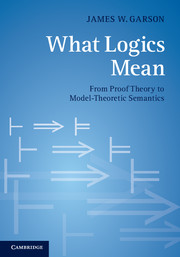Book contents
- Frontmatter
- Dedication
- Contents
- Preface
- Acknowledgements
- 1 Introduction to model-theoretic inferentialism
- 2 Deductive expression
- 3 Local expression
- 4 Global expression
- 5 Intuitionistic semantics
- 6 Conditionals
- 7 Disjunction
- 8 Negation
- 9 Supervaluations and natural semantics
- 10 Natural semantics for an open future
- 11 The expressive power of sequent calculi
- 12 Soundness and completeness for natural semantics
- 13 Connections with proof-theoretic semantics
- 14 Quantifiers
- 15 The natural semantics of vagueness (with Joshua D. K. Brown)
- 16 Modal logic
- Summary
- References
- Index
5 - Intuitionistic semantics
Published online by Cambridge University Press: 05 June 2014
- Frontmatter
- Dedication
- Contents
- Preface
- Acknowledgements
- 1 Introduction to model-theoretic inferentialism
- 2 Deductive expression
- 3 Local expression
- 4 Global expression
- 5 Intuitionistic semantics
- 6 Conditionals
- 7 Disjunction
- 8 Negation
- 9 Supervaluations and natural semantics
- 10 Natural semantics for an open future
- 11 The expressive power of sequent calculi
- 12 Soundness and completeness for natural semantics
- 13 Connections with proof-theoretic semantics
- 14 Quantifiers
- 15 The natural semantics of vagueness (with Joshua D. K. Brown)
- 16 Modal logic
- Summary
- References
- Index
Summary
In this chapter, we will lay the groundwork for showing that the natural semantics for natural deduction formulations of propositional logic is intuitionistic. In Section 5.1, we present Kripke’s semantics for intuitionistic logic, which is a variant of the semantics for the modal logic S4 (van Dalen, 1986, pp. 243ff.). In Section 5.2, intuitionistic models are introduced. Intuitionistic models are sets of valuations V that satisfy conditions for each of the connectives that resemble the corresponding truth conditions for Kripke models. Intuitionistic models, being sets of valuations of a certain kind, lack the structure found in Kripke models, notably the accessibility relation ⊆. In intuitionistic models, the analog ≤ of ⊆ has to be defined by the way valuations in V assign values to the wffs. Section 5.3 discusses the objection that the conditions that mention ≤ are therefore circular or fail to meet other standards for a successful account of recursive truth conditions. The proof that there is an isomorphism between structures generated by intuitionistic models and Kripke models (Section 5.4) helps respond to those objections. A further constraint for successful truth conditions is defined (Section 5.5), and it is shown that intuitionistic models meet it. This supports the contention that intuitionistic models count as a legitimate account of connective meaning, and prepares the way for the results on natural semantics that are proven in later chapters.
Kripke semantics for intuitionistic logic
Kripke’s semantics (1963) is a simplification of the topological semantics developed in the 1930s by Heyting and refined by Kreisel. The main idea is to define truth relative to the history of discovery of an idealized mathematician (or community of mathematicians). At each point in that history, a body of mathematical results has been developed. Since perfect memory of past results is presumed, that body of knowledge grows as time proceeds. At each stage in the history, the mathematician has choices concerning which topics should be investigated next. The collection of choices for future research can be modeled as a branching structure with forks representing the choice points.
- Type
- Chapter
- Information
- What Logics MeanFrom Proof Theory to Model-Theoretic Semantics, pp. 57 - 70Publisher: Cambridge University PressPrint publication year: 2013



